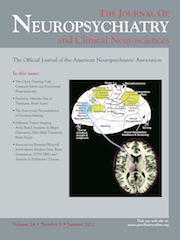Possible Paliperidone-Induced Neuroleptic Malignant Syndrome: A Case Report
To the Editor: Paliperidone, the major active metabolite of risperidone, is one of the newest second-generation antipsychotics shown to be effective in treating schizophrenia.1 The neuroleptic malignant syndrome (NMS) is a life-threatening reaction to antipsychotic medication. It may occur during treatment with any antipsychotic agent.2 The present case describes the evolution of NMS after the addition of paliperidone to amisulpride and withdrawal of clozapine.
Case Report
A 22-year-old man with a 5-year history of schizophrenia was hospitalized for worsening of persecutory and somatic delusions, agitation, and anorexia. For months, he had been on various neuroleptics, with partial response. On admission, clozapine was started and titrated to 250 mg daily in 3 weeks. Because of severe hypersalivation, 200 mg/day amisulpride was added. After 4 weeks, clozapine was tapered gradually because of persistant sedation and hypersalivation. Also, the patient had no response to clozapine; his somatic delusions persisted and were associated with his refusal to eat or drink. In the 5th week, clozapine was tapered to 100 mg/day, and paliperidone 6 mg daily was added to amisulpiride 200 mg/day, and, by the 6th week, clozapine was stopped, and paliperidone was increased to 9 mg/day. By the 10th day after initiation of paliperidone, the patient was noted to be diaphoretic and in moderate distress. Physical examination demonstrated tremulousness in all extremities. By the 12th day, he had generalized rigidity, and he became febrile (38.5°C oral); pulse rate was 120; blood pressure was 140/90 mmHg. He was fully oriented, although his alertness to his environment was mildly disturbed, and he was easily distracted. Laboratory studies showed increased creatine phosphokinase (CPK; 3,946 IU/liter [reference range: 0–200]), aspartate aminotransferase (98 IU/liter; reference range: 0–35), total leukocyte count was 7,300/mm3; total neutrophil count was 5,400/mm3; platelets were 220.000/mm3. His renal functions and serum electrolytes were within normal range. Blood and urinary cultures were negative; the chest X-ray and cranial CT were unremarkable. A presumptive diagnosis of neuroleptic malignant syndrome (NMS) was made. Amisulpride and paliperidone were immediately discontinued, and supportive care initiated (parenteral hydration and as-needed acetaminophen). During the first week, he received bromocriptine 7.5 mg daily and a total of 5 mg lorazepam. Muscular rigidity and fever abated within 72 hours after discontinuation of amisulpride and paliperidone. All other features of NMS resolved on the 5th day. His CPK level dropped to 309 U/liter in 2 weeks. After discontinuation of antipsychotics, somatic and persecutory delusions and agitation gradually increased. Lorazepam was discontinued in 10 days, and, instead, diazepam 20 mg daily was continued for 2 weeks. He was discharged from the hospital in a psychotic condition at his family’s request.
Discussion
This patient met the DSM-IV-TR criteria for NMS.Severe muscle rigidity and elevated temperature associated with the use of neuroleptic medication as well as two or more of the following (diaphoresis, dysphagia, tremor, incontinence, changes in level of consciousness ranging from confusion to coma, mutism, tachycardia, elevated or labile blood pressure, leukocytosis, laboratory evidence of muscle injury).3 Although he did not show extreme hyperthermia, his cognition was mildly disturbed, and autonomic instability was not prominent. This may be due to early recognition of the condition and prompt discontinuation of antipsychotics. Paliperidone was implicated in this adverse effect because of the temporal relation between appearance of NMS symptoms and addition of paliperidone to amisulpride. The neurotoxic reaction might also be caused by the cumulative effect of paliperione and amisulpride. However, NMS has been described with neuroleptic discontinuation, and the contribution of clozapine in this presentation cannot be entirely excluded, although this is unlikely in this case because most NMS cases associated with drug wihdrawal are observed after abrupt discontinuation of the related drug.4 This case underlies the importance of early recognition of NMS and also alerts clinicians to its association with paliperidone, which is expected, as NMS has been reported with risperidone.2
Cases of paliperidone-induced neuroleptic malignant syndrome have previously been reported.5–9 The treatment of treatment-resistant patients with psychotic disorders urges the clinicians to give multiple antipsychotic durgs simultaneously or successively which may result in greater risk of NMS. High on the list of conditions suspected to promote the syndrome is dehydration,10 which may have contributed to the neurotoxic reaction in our case. However, the addition of an agent with high dopamine-receptor affinity to existing second-generation antipsychotic treatment appears to have been a key factor in this case.
1 : Essential Psychopharmacology, 2nd ed. New York, Cambridge University Press, 2004, pp 401–458Google Scholar
2 : [Neuroleptic malignant syndrome and atypical antipsychotics: a brief review]. Encephale 2008; 34:618–624Crossref, Medline, Google Scholar
3
4 : Clozapine withdrawal catatonia and neuroleptic malignant syndrome: a case report. Ann Clin Psychiatry 1997; 9:165–169Crossref, Medline, Google Scholar
5 : Paliperidone extended-release tablets for prevention of symptom recurrence in patients with schizophrenia: a randomized, double-blind, placebo-controlled study. J Clin Psychopharmacol 2007; 27:6–14Crossref, Medline, Google Scholar
6 : Possible neuroleptic malignant syndrome associated with paliperidone. J Neuropsychiatry Clin Neurosci 2007; 19:477–478Link, Google Scholar
7 : Possible neuroleptic malignant syndrome during paliperidone administration: a case report. J Clin Psychopharmacol 2010; 30:89–91Crossref, Medline, Google Scholar
8 : Paliperidone-associated atypical neuroleptic malignant syndrome: a case report. Prog Neuropsychopharmacol Biol Psychiatry 2011; 35:650–651Crossref, Medline, Google Scholar
9 : Paliperidone-induced neuroleptic malignant syndrome. J Neuropsychiatry Clin Neurosci 2011; 23:E14–E15Link, Google Scholar
10 : Neuroleptic malignant syndrome: a review. Psychiatr Serv 1998; 49:1163–1172Crossref, Medline, Google Scholar



